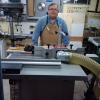I've been trying to adjust my hammer a331 and noticed the indeed table seems to dip down from the cutterhead to the other end quite a bit. It starts off being co planer with the outfeed but as shown in the picture it dips down quite a bit. Wondering if this is a big issue? My joints do seem to be pretty open in the middle and wondering if this is a cause.
20220426_211750.jpg20220426_211826.jpg




 Reply With Quote
Reply With Quote




